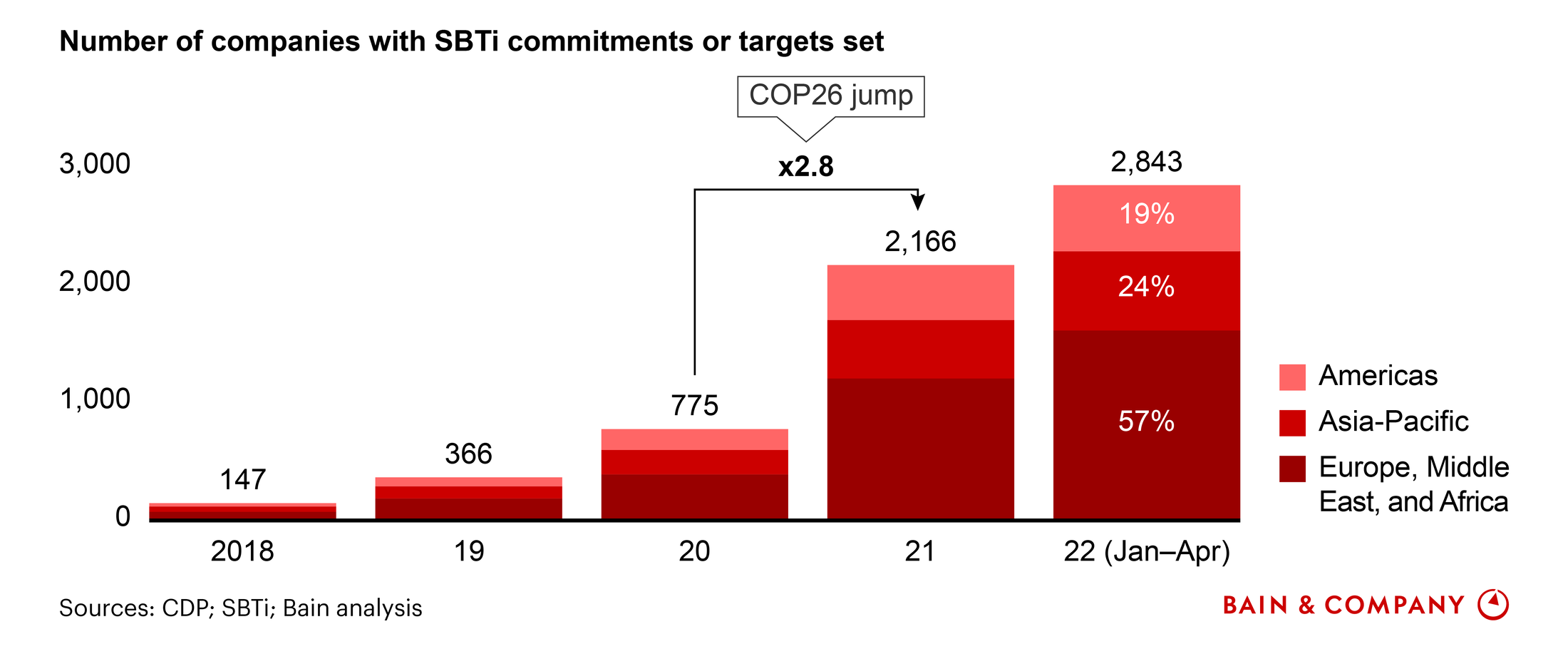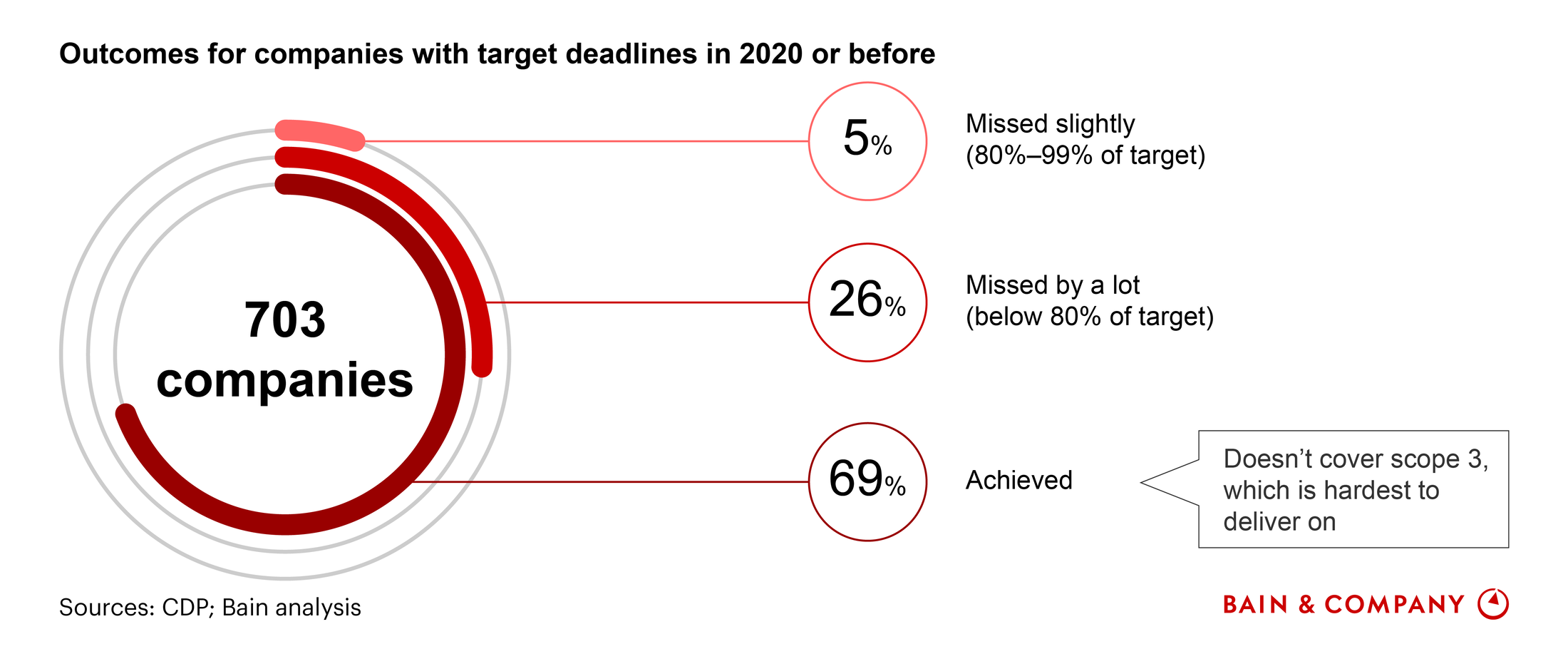It will take a combination of vision and pragmatism for companies to reach their decarbonization goals, says Bain & Company.
Companies that make the most progress will stay focused on their visionary net zero ambition while showing ruthless pragmatism in delivering strategically. The year 2021 was about ambition setting. The number of companies establishing science-based targets for decarbonization had strongly increased since 2015, but it rose dramatically from 2020 to 2021, in the run-up to COP26, the United Nations Climate Change Conference (see Figure 1).

Figure 1: The number of companies pursuing science-based targets has nearly quadrupled since 2020
Now, 2022 and beyond will be about delivering on and monetizing those ambitions. The world will eventually get to net zero—but the critical issue is getting there in time to limit global warming to 1.5 degrees Celsius. The urgency is real: Reaching net zero by 2050 requires halving emissions between 2020 and 2030.
It’s not surprising that many CEOs feel overwhelmed as they face the climate challenge. There’s no shortage of headlines highlighting the trillions of dollars it will take to green the economy. And the opportunities are endless, with possibilities to exponentially grow customer demand for green products.
Yet the day-to-day work of turning ambition into reality is undeniably challenging. Consider that 31% of companies missed scope 1 and 2 targets they set for 2020 with the Science Based Targets initiative—despite the fact that these emissions are the most controllable and there are many options available to address them (see Figure 2).

Figure 2: Achieving emissions targets, even for scope 1 and 2 only, is difficult
Of course, all of this is not happening in a green vacuum. Executives are trying to pursue their decarbonization targets during a period of turbulence that has created historic levels of uncertainty and numerous difficulties. They are grappling with ways to make an orderly carbon transition amid an unsettling geopolitical atmosphere, chronic supply chain disruptions, and rampant inflation.
To translate ambition into delivery, leaders will need to adopt a mindset that we call visionary pragmatism. Organizations that meet their decarbonization goals bring dreamers and doers on the executive team together to get five things right.
-
Put a premium on strategic adaptability
Companies don’t need more climate scenarios but, rather, clarity on the relevant ones. They also need to watch the signposts that will indicate what’s coming next, especially regulations and advances in technology. The best companies will embrace an adaptable approach to strategy.
-
Proactively address investor dissonance
Investors as well as lenders are increasingly assertive and discerning about decarbonisation expectations. At the same time, they may not be willing to compromise on near-term returns. There is often dissonance between a company’s green ambitions and its growth and return aspirations, and often a perception that there will be trade-offs. Many capital markets day events have become longer, but not clearer.
Executives need to strengthen the investor dialogue. That means focusing on strategic clarity, with both concrete near-term plans to achieve decarbonization commitments and pathways to net zero. They should emphasize specific proof points showing that decarbonization is happening and that it contributes to making the business more valuable.
-
Decarbonise customer-back
In many sectors, the bulk of emissions happen when customers use the products that companies sell (downstream scope 3 emissions). In addition, what the customer wants deeply impacts embedded emissions generated during production and in the supply chain. Companies that are most successful in their climate transitions start decarbonization with the customer in mind and work backward across offerings, operations, and the supply chain.
-
Collaborate where it matters and for results
Carbon transition is a problem far too big to be solved by any company on its own, and the need to engage the wider ecosystem of customers, suppliers, peers, governments, and civil society is increasing. Executives must decide where to collaborate vs. compete, picking the few partnerships that can make a difference. They should forge those partnerships across the value chain, or with peers or NGOs, to reach a critical mass for change. It’s important not to lose precious time on initiatives where there’s much talk but little action. Instead, aim to ruthlessly deliver results with a clear intent for the partnership, and with early proof points gained through experimentation.
-
Create net-zero heroes in middle management
Top management usually is fully convinced of the need for aggressive decarbonization, given interactions with investors, the board, and key customers. New recruits often have chosen an employer based on its green credentials. Yet companies may lack committed middle management to get the job done. Too often, middle managers get bogged down when required to deliver key performance indicators for ESG on top of those for revenues, costs, and safety, for example. Sometimes, they’re asked to do it without explanation or help in making trade-offs.
How can they become net-zero heroes? The only way to create effective green middle management is to be extremely clear about which decisions to make differently and how to resolve trade-offs. The organization needs to be trained, guided, and aligned to embed their goals as realistic deliverables.
The whole organization needs to be upskilled, though not to the same level or the same purpose. That starts by investing to understand who is most impacted and needs the most training, and then rolling out support accordingly.
***
The urgency of decarbonization and the need to limit global warming to 1.5 degrees are largely undisputed. Most companies raced to establish their targets in time for last year’s COP26. Now, as they come face to face with the hard part—delivering on those ambitions and the opportunities available by greening the business—those that combine vision and pragmatism will get there first.
If you’re interested in hearing more, join Bain at the CBI conference: Achieving Net Zero on 7-8 June.









